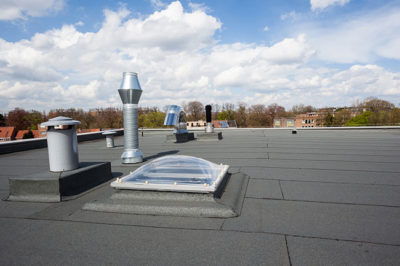What Flat Roof Options are Available?
 When most people hear the word “roof,” they think of a upside-down, V-shaped structure that sits on the top of most homes. While not as common, purely horizontal or “flat” roofs also exist especially on office and commercial buildings. All flat roofs contain a supporting substructure, decking made of oriented strand board (OSB) and a waterproofing layer that leads to a drain or gutter system. They are then differentiated by what covers this infrastructure. Here is a quick rundown on what final layer options are available to home and business owners looking to install a flat roof.
When most people hear the word “roof,” they think of a upside-down, V-shaped structure that sits on the top of most homes. While not as common, purely horizontal or “flat” roofs also exist especially on office and commercial buildings. All flat roofs contain a supporting substructure, decking made of oriented strand board (OSB) and a waterproofing layer that leads to a drain or gutter system. They are then differentiated by what covers this infrastructure. Here is a quick rundown on what final layer options are available to home and business owners looking to install a flat roof.
Traditional Flat Roof
The simplest and, by far, oldest method for completing a flat roof is to cover it in felt paper and multiple layers of liquid tar or asphalt. As the liquid solidifies on top of the paper, these two materials combine to create a watertight covering. A final “flood” coat of tar is applied and gravel laid on top. This final layer offers protection from physical damage to the lower layers and also helps to secure those layers to the substructure.
Protected Membrane Roofs (PMR)
In a PMR-constructed roof, an additional layer of extruded polystyrene is installed over the waterproofing layer. These rigid panels protect the underlayment from mechanical damage and thermal shock as well as degradation from ultraviolet light. In short, it is a high-tech variation on the traditional method – one that is more cost-effective and less maintenance intensive over the long run.
Green Roofs
Technically, green roofs are a type of PMR that uses natural materials instead of man-made ones. Older civilizations such as the Vikings and the Mongols have used them for centuries but they fell out of favor in more modern times because of their high maintenance requirements. These days, however, green roofs are renowned for their heat buffering capabilities. They not only protect the building from heat during daytime hours but slowly release it at night.
Green-Roof Water Buffering
These roofs take their environmental responsibility a step further than standard green roofs by also tackling the problem of excessive run-off from rain storms. As their name implies, these systems act as buffers against excessive rainwater entering the sewer system of a locality. Instead, the water is stored in the roof, used by the grass and other foliage and gently released back into the atmosphere.
Brown Roofs
One of the more novel approaches to flat roof construction is the utilization of otherwise discardable items on a construction site to build the flat roof. The “rubble” is carted up onto the roof instead of to a disposal site thus saving money. In addition, the rubble is naturally colonized by flora that are intrinsic to the area saving further installation and maintenance costs. While some may consider the weeds associated with this type of flat roof to be an eyesore, the roof is no readily visible from the ground floor. In short, it is a win-win situation for the builder and the environment.
As you can imagine, there are a lot of engineering details that need to be ironed out before installing a flat roof. In particular, the live dead requirements can vary enormously and the water outtake system must be adequate to handle the fall of the most torrential downpour or disaster may ensue. It is a task not best left to amateurs. For more information on the process and on other flat roof options available to home and business owners, please contact the professionals at All-Nu Construction. We can be visited online at or reached directly at 419.242.5568.

